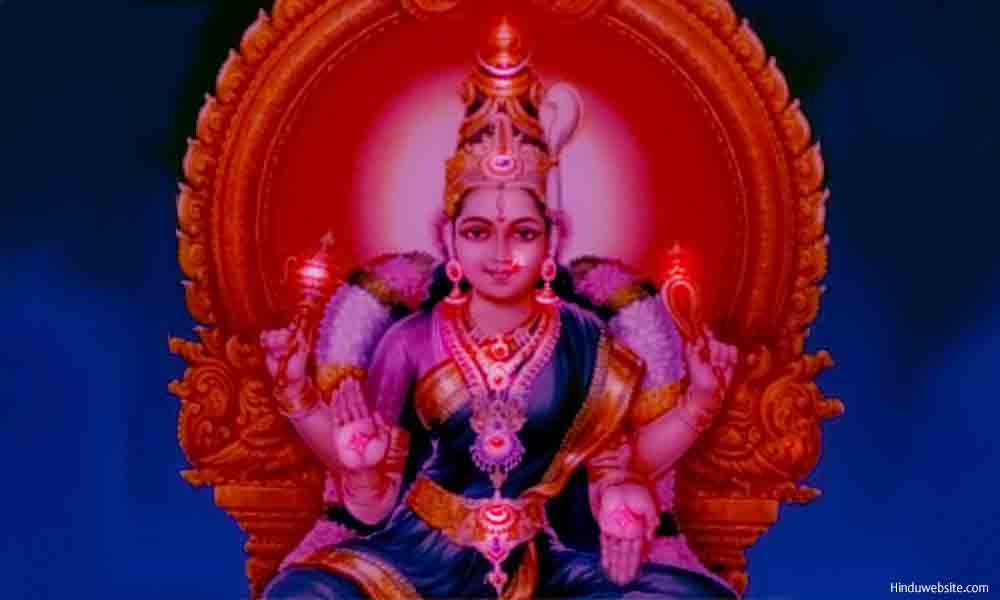
Shree Raja Rajeswari Sthavam

Aum, Bhagavathee Sri Raja Rajeswari
Raja Rajeswari means the the lord of the lords, or the king of kings. In Hinduism, she is one of the highest aspects of Shakti or Parvathi, the consort of Shiva. Since she is the ruler of the universe, the name, Raja Rajeswari, aptly fits her. In the Lalitha Sahsranamam she is mentioned as an aspect of Sri Lalitha Tripura Sundari. In the following sthavam (a poem of praise) addressed to her, she is extolled by many names and described as eternally youthful, auspicious, the wealth of empires, ruler of the rulers, and the slayer of Dhumraakhsa, an asura.
In the images she is generally depcited as a beautiful and youthful godess, sitting on a golden throne, holding in her four hands an ankusa (a sharp object to control elephants), a pasa ( a rope denoting bondage), a sugarcane stalk, and a lotus. The last one also is held in the gestire of abhaya (assurance). Devotees believe that when she is pleased by devotion, she grants power, authority, rulership, and wealth to her devotees and protects them from enemies. There are many temples of the goddess in different parts of India, including Varanasi, where according to local legends, the goddess is said to be very powerful, and devotees may often feel her presence in the temple.
Guidelines for pronunciation are in the footnotes
shree raaja raajeshwaree sthavam
ambaa shaambhavi chandramouli rabala | aparnaa umaa parvathee
kaalee haimavathee shivaa thrinayanee | kathyaayanee bhairavee
saavithree nava yauvanee shubhakaree | saamraajya lakshmeeprada
chhidruupi paradevathaa bhagavathee shree raaja raajeshwaree
|
ambaa mohini devathaa thribhuvanee | aananda sandhayanee
vaanee pallava paani venu muralee gaana | priyaa lolinee
kalyaanee udu raaja bimba vadanaa | dhumraksha samharinee
chhidruupi paradevathaa bhagavathee shree raaja raajeshwaree
|
ambaa nuupura rathna kankana dharinee| keyuura haaraavalee
jaajee champaka vaijayanthi laharee | graiveya vairaajithaa
veenaa venu vinoda manditha karaa | veeraasane samsthithaa
chhidruupi paradevathaa bhagavathee shree raaja raajeshwaree
ambaa raudrini bhadra kaali bagalaa | jvaalaamukhee vaishnavee
brahmanee thripuranthakee sura suthaa | dedeepya maanojvala
chaamundee sritharakshaposha jananee | daakshayanee pallavee
chhidruupi paradevathaa bhagavathee shree raaja raajeshwaree
ambaa shuuladhanuh kushaankushadharee | ardhendu bimbaadharee
vaaraahi madhu kaitaka prashamanee | dedeepyamaanojjvalaa
chaamundee sritharaksha posha jananee | dakshaayanee pallavi
chhidruupi paradevathaa bhagavathee shree raaja raajeshwaree
ambaa shrishti vinaasha paalanakaree | aaryaani samshobhithaa
gaayathree pranavaaksharaamruthaa rasah | puurnaanu sandhee
kruthaa
aumkaari vinuthaamaaraarchi thapadaa | uddandadaithyapahaa
chhidruupi paradevathaa bhagavathee shree raaja raajeshwaree
ambaa shaankari aagamaadi vinuthaa | aaryaa mahaa devathaa
yaa brahmaadi pipeelikaantha jananee | yaa vai jaganmohinee
ya panchathpranavadvi repha jananee | yaa chithkalaammaalinee
chhidruupi paradevathaa bhagavathee shree raaja raajeshwaree
ambaa paalitha bhakta raaja ranisham | ambaashtakam yah pattehd
ambaa loka kataaksha veeksha lalithaa | aishvarya mavyahathaa
ambaa paavana manthra raaja patthanaa | danthyena moksha pradaa
chhidruupi paradevathaa bhagavathee shree raaja raajeshwaree
Suggestions for Further Reading
- Popular Prayers of Hindu Gods and Goddesses
- Aspects, Emanations, Incarnations and Forms of God Vishnu
- Hindu God Vishnu, the Preserver
- Dainya Ashtakam
- Sri Gopala Ashtakam
- Sri Gopala Sthavam
- Govardhana Ashtakam
- Sri Govardhana Dharashtakam
- Sri Krishna Ashtakam
- Sri Krishna Ashtakam by Vallabhacharya
- Sri Krishnashraya Sthothram
- Sri Krishna Dvadasanama Sthothram
- Sri Krishna Sharana Aasthakam
- Sri Krishnashtaka Sthothram
- Sri Krishna Sthothram
- Sri Krishna Thandava Sthothram
- Sri Madhurashtakam
- A Prayer During a Pradakshina at a A Hindu Temple
- Salutations to Dikpalas, Rishis and Devathas
- Ganapathya Atharvashirsham
- Shri Ganesha Ashtotthara Sathanama Puja
- Essays On Dharma
- Esoteric Mystic Hinduism
- Introduction to Hinduism
- Hindu Way of Life
- Essays On Karma
- Hindu Rites and Rituals
- The Origin of The Sanskrit Language
- Symbolism in Hinduism
- Essays on The Upanishads
- Concepts of Hinduism
- Essays on Atman
- Hindu Festivals
- Spiritual Practice
- Right Living
- Yoga of Sorrow
- Happiness
- Mental Health
- Concepts of Buddhism
- General Essays
Guidelines to pronunciation: Sanskrit is essentially a language of sounds and sound vibrations. The efficacy of Sanskrit prayers depends upon the vibrations that are produced during chanting. It is difficult to transliterate Sanskrit words into English with full justification to the original sounds. In the above stated transliteration we followed a simple approach to make it easier even for those who are not familiar with English or Sanskrit. Wherever you find repeat vowels (aa, uu, ee) please stretch the vowel sound (for ex., aa as in vast or path, uu as in cool or root, ee as in eel or feel). Similarly, "ai" should be pronounced as in gait, fight, or tight. Th should be pronounced as in think or thick, but when t alone is used, it should be pronounced as in two, top or tip.